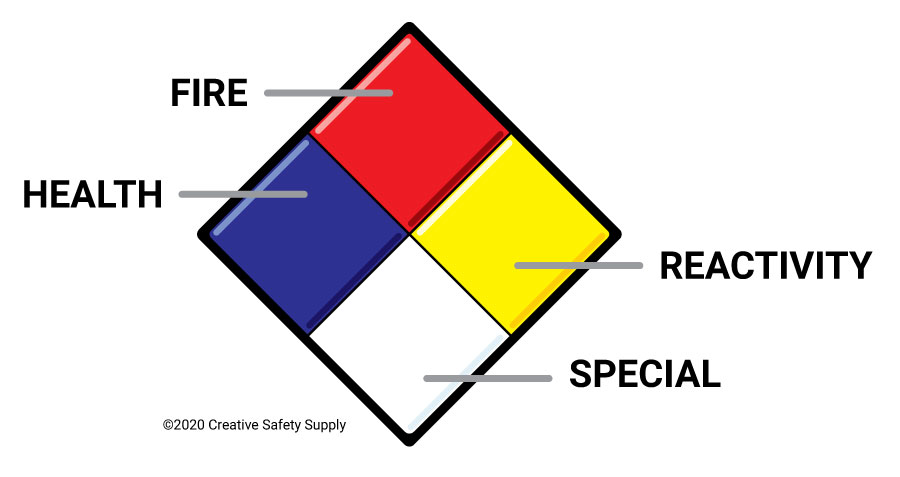
Multi-colored fire diamonds, a common fixture on tanks and buildings, are a way of communicating risks quickly to firefighters, and other first responders. They can help determine a number of things like what precautions to take, procedures to follow, and equipment to use.
The fire diamond is part of the Standard System for the Identification of the Hazards of Materials for Emergency Response (NFPA 704). In this type of standard, hazardous chemicals are classified into three principle categories: health, flammability, and instability. Each category is then rated on a scale of zero (least severe hazard) to four (extremely dangerous) and printed in one of four color-coded squares within the diamond:
Blue Square/Health Hazard: Indicates the capability of a material, under emergency circumstances. For example, injury due to skin contact, eye contact, inhalation, or ingestion.
0 – Not hazardous.

1 – Slightly hazardous and can cause significant irritation.
2 – Toxic; can cause temporary incapacitation or residual injury.
3 – Extremely hazardous/highly toxic; can cause serious or permanent injury.
4 – Lethal/deadly
Red Square/Fire Hazard: Represents how susceptive the material is to ignition or burning.
0 – Does not burn
1 – Flash point above 200°F; materials that must be preheated before it can be ignited.
2 – Flash point above 100°F but doesn’t exceed 200°F; materials that must be moderately heated or exposed before ignition can occur.
3 – Flash point below 100°F; materials that can be ignited under almost all ambient temperatures.
4 – Flash point below 73°F; materials that burn readily and can ignite spontaneously.
Yellow Square/Reactivity & Stability Hazard: Represents the degree of hazard based on reaction with air and light.
0 – Stable/non-reactive; substance is not considered explosive
1 – If heated material becomes unstable; substance is considered explosive.
2 – Violent chemical change possible at elevated pressures and temps; substance is considered explosive.
3 –If substantial shock or heat applied, material may detonate; substance is considered explosive.
4 – May detonate; substance is considered very explosive and is readily capable of detonation at normal temperatures.
White Square/Special Hazards: Materials with water reactivity and oxidizing properties cause special problems and typically require special firefighting measures. Typically left blank, but when necessary, the following chemical symbols and acronyms can be used:
ALK – Alkaline
COR-OX – Corrosive Oxidizer
CRY - Cryogenic
OXY – This is the same as OX, it stands for Oxidizer
W (NFPA Approved) – Do not use with water
RAD - Radioactive
Acid – Acid
COR – Corrosive
COR-OXY – Corrosive Oxidizer
OX (NFPA Approved) – Oxidizer
SA (NFPA Approved) - Simple asphyxiant gas
W+OX – Do not use with water, oxidizer
Additional NFPA Fire Diamond facts:
- The NFPA Fire Diamond, also known as the NFPA 704, is a standard system for the identification of the hazards of materials for emergency response. It was designed in 1960 by the National Fire Protection Association, as a way of quickly telling firefighters and other emergency workers what kind of dangers might be nearby. Source: https://en.wikipedia.org/wiki/NFPA_704
- The four divisions of the NFPA Fire Diamond are typically color-coded with red on top indicating flammability, blue on the left indicating level of health hazard, yellow on the right for chemical reactivity, and white containing codes for special hazards. Each of health, flammability and reactivity is rated on a scale from 0 (no hazard) to 4 (severe hazard). Source: https://www.thoughtco.com/what-is-nfpa-704-or-the-fire-diamond-609000
- The NFPA Fire Diamond is an internationally accepted safety standard, and is crucial while transporting chemicals. It helps determine what, if any, special equipment should be used, procedures followed, or precautions taken during the initial stages of an emergency response. Source: https://en.wikipedia.org/wiki/NFPA_704
- The NFPA Fire Diamond is not intended to be a comprehensive guide for all hazards of a material, but rather a quick reference for the most common ones. It does not provide information on the toxicity, environmental impact, or chronic health effects of a material. Source: https://hsewatch.com/nfpa-diamond/
- The NFPA Fire Diamond is sometimes confused with the Hazard Communication Standard (HCS) pictograms, which are used to label containers of hazardous chemicals in the workplace. The HCS pictograms are based on the Globally Harmonized System of Classification and Labelling of Chemicals (GHS), and have different meanings and symbols than the NFPA Fire Diamond. Source: https://www.osha.gov/sites/default/files/publications/OSHA3678.pdf
Similar Glossary Terms
- HMIS
- MSDS
- Corrosive Chemicals
- Fire Hazard
- Health Hazard
- Fire Prevention Plan
- Fire Suppression System
- NFPA
- HazMat
Additional Resources
Employers can find the information they need to create fire diamonds in the chemical’s safety data sheet. In addition to NFPA labels, employers will need to comply with OSHA’s Hazard Communication Standard and provide GHS labels and access to Safety Data Sheets (SDS).


